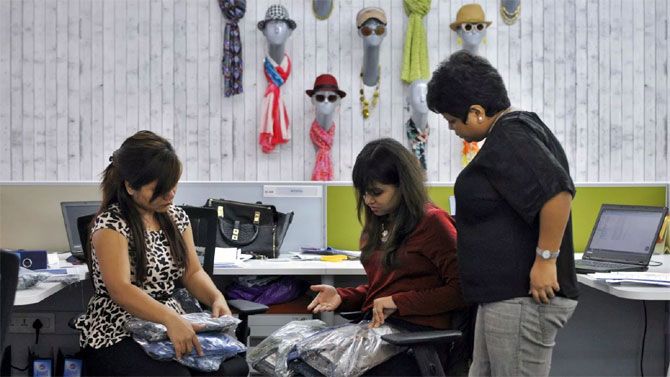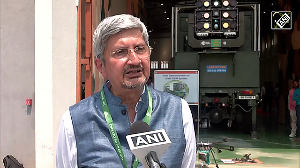Being 'employee light' is the latest fad.

The Internet lowers transaction costs, and helps us create new business models, where fewer and fewer things need to be done in-house in organisations.
Asset light is a catch-phrase that you would always hear in the business world.
With both knowledge and talent available on-demand, we see an emergence of a new kind of model -- "employee light."
This model helps you de-risk various aspects of your business without committing to any long-term ongoing costs.
Will bring this out in a story of a start-up I've had the privilege of seeing up close and personal. It underscores for me that the one thing an entrepreneur needs is ideas.
Genesis: Corner offices and Whiskey
Our story starts with two professionals, let's call them Ideator and Mediator, looking out of the window of their corner offices, contemplating what they should do next. But this isn't an HBS case study, so we fast forward to that evening, throw in a very smart guy they know, let's call him Connector.
The conversation went to a problem they notice in their industry which affects every professional in that space in India (over one million).
These professionals spend anything from Rs 5,000 to Rs 50,000 a year to solve this problem.
They started formulating a plan on how to go from idea to business.
Now this Connector was an interesting guy. He carried multiple hats wherever he went -- some people also call him the Mad Hatter, but that's a story for another day.
A quick change of Hats, and Connector metamorphose into Gregor. For the sake of his privacy, let's refer to Gregor by his day job -- Driver.
Driver's job was to have a plan, drive time-frames, people and deliverables towards achievement of the end-goal.
With the addition of Driver, the permanent team was complete, and Driver started repeating his catch phrase: What are the next steps. It emerged quickly that first and foremost, they needed a tech guru.
Getting Techy with it
Not the long hair and saffron robes kind, but the long hair and bearded kind, who throws around words like Ubuntu, LAMP and Django. So Connector called his friend Guru.
Guru is a genius savant who understands technology (at least the building of an app kind) from front to back, but was also well connected to the ground realities.
Guru told the motley crew that while Ruby was hot, and Python was slick, the most developers were available in PHP, so PHP would be the core technology.
Guru took the role of part-time CTO, tech recruiter, and general sounding board of the business plan.
Driver, Guru, Ideator and Mediator spent a few hours in various coffee shops, and Driver created the first specification document of the app.
While the team left Guru to his own devices to come up with the DB schema and architecture, and Restful APIs and whatnot, Driver identified the need for a designer, since the team was aesthetically challenged, to say the least.
De-sign me up
Driver went into a phone booth in the middle of Khan Market, and Connector stepped out somehow and called his old buddy Maestro.
Maestro smokes a pipe, drives an Enfield, and speaks in profound utterances that sound deep, and make you feel stupid, all at once.
In the first meeting with Maestro, he only asked one question. Not about market, target group, features. Just one question, scribbled a few things, and then disappeared.
"What's the promise?"
In the meantime, Guru found and contracted Ninja, an ex-colleague of his. Ninja is the rare truly full-stack developer who's good at both front and back-end development.
Around the same time, Maestro retired from human company to his cave, which conveniently doesn't receive Airtel signal (all of Delhi doesn't receive Vodafone signal anyway), and emerged few weeks later with the wireframes.
Let's get this party started
Driver made sure that Ideator and Mediator were happy with the wireframes, and the flow that was defined as per expectations. He also ensured that Guru signed off on them too, as easily implementable.
Now Guru got Ninja started on the app screens, while Maestro started building the visual designs from the wire-frames.
As the app started moving towards completion, Driver looked ahead, and identified the need for marketing the app.
Connector thought hard, meditated, and SMS (Social Media Swami) appeared. SMS speaks in staccato, and you catch terms like CAC, CTR, Millenial, GDN and some other lingo.
Luckily Connector speaks both English and Digital, so he translated for the group. SMS met the team a few times, looked at the app design, and quickly charted out the go to market strategy, at a tremendous level of detail, including daily and weekly budgets, conversion targets, and other good stuff.
Raring to Go: Present Day
Lo and behold, the app is ready today, and the team is planning a second week of October launch.
Driver, Maestro, Ninja and Guru have disengaged with the project (with Ninja committing to provide support for the next 12 weeks).
Ideator and Mediator are raring to get going, and are working daily with SMS. They have now quit their jobs, and ready to take this to prime-time.
In summary, the best source of talent is free (your Connectors)
PS: All these are real people. Their names have been changed.
The author is an alumnus of ISB and Tulane University, he now looks after Business Development and odd jobs at Flexing It.
Lead image used for representational purposes only. Image: Abhishek N Chinnappa/Reuters












 © 2025
© 2025